Most gardeners, I think, want to bring a bit of the wilder natural world into their home landscapes. This doesn’t mean an unkempt look, but it does often mean imitating and interpreting the natural structure, form and layout of a prairie, woodland or even desert. Plants form communities. Plants colonize. Plants rely on family and friends to grow well as they share information and resources through their scents and roots.
One way to create a beautiful garden that’s lower maintenance and emulates nature is to use drifts and masses. Here are seven ways to design with this method — and the reasons for doing so.
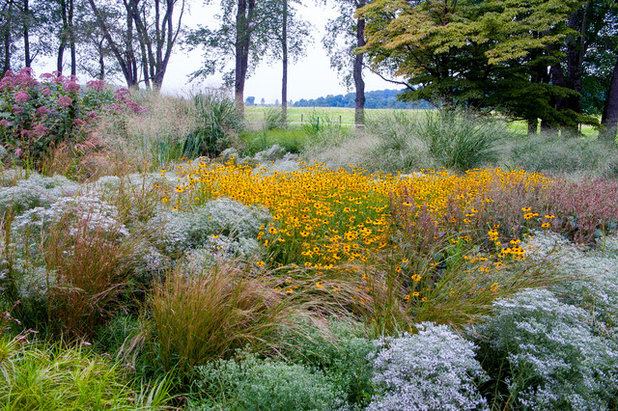
jonathan alderson landscape architects, inc.
1. Create a wilder look. Nature expresses self-similarity — it repeats itself over and over in patterns that can be mapped mathematically. In other words, nature is a geometric fractal, a pattern that duplicates itself on small and grand scales. Think snowflakes, coneflower heads, trees, mountains and coastlines.
In a garden you can intermingle drifts of plants. Toss in a few massed clumps of flowers amid a backdrop of grasses, then repeat that flower and grass pattern elsewhere on a larger or smaller scale — say, three of a kind here, seven of a kind there. If you have a large area, you can do this with bigger plants and more of them; in a small space, choose smaller plants with a more limited species palette.

Arthur Road Landscapes
2. Keep smaller spaces simple. Going with a smaller plant palette doesn’t mean limiting your choices or garden experience. A small space can quickly become overwhelmed and chaotic when there are too many plant species or their size overwhelms the space. Think about shorter plants and using more of one kind. Let’s say you have a 100-square-foot garden — maybe you’d use four to six different plant species but have 10 of each. Then if you clump them together or have drifts intermingle, you create intrigue and formal style without the perceived visual chaos of more plant species.
Learn how to focus your garden palette
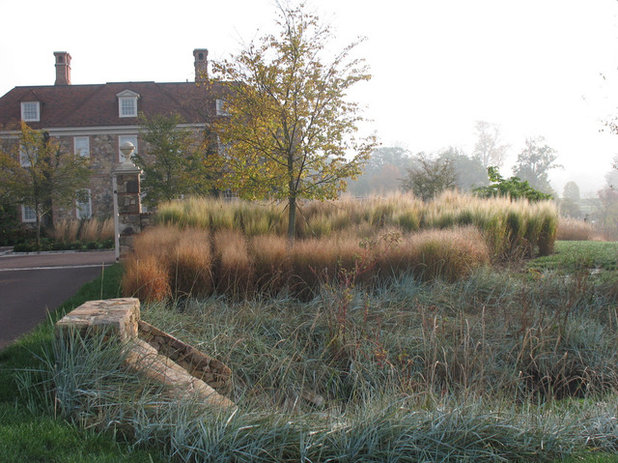
jonathan alderson landscape architects, inc.
3. Tie a larger landscape together. The balance and weight of plant drifts can anchor a view in a larger landscape and prevent it from overwhelming or becoming visually dysfunctional. A large swath of the same grasses balances the heft of a built structure or grove of trees, or lends a more formal air when flanking a visual centerpiece, like a house.
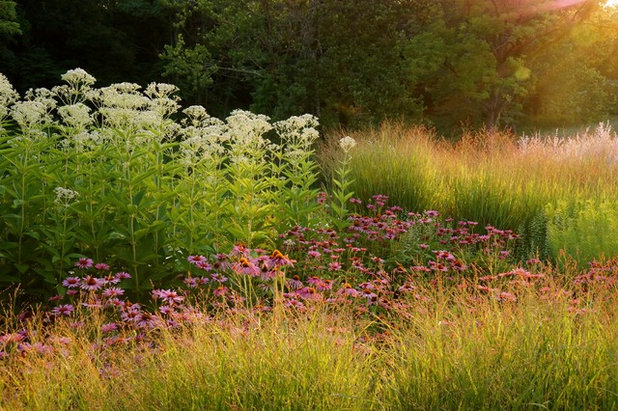
Adam Woodruff + Associates, Garden Artisans
This is a close-up of a much larger garden, but you can see how drifts and masses are working on both informal and formal levels among the plants themselves. Grasses up front encircle the coneflowers, while both lead up to the taller Joe Pye Weed blooming white. There’s both a formal, stepped succession of height we expect in a tended garden, and a more informal surprise as the viewing angle changes from point to point; the intermingling drifts provide new vistas as we walk the landscape, creating surprise and cohesion at the same time.
Plants shown (click photo to see the plants tagged): Spotted Joe Pye Weed (
Eupatorium maculatum ‘Bartered Bride’, USDA zones 3 to 8; find your zone), Ruby Star purple coneflower (
Echinacea purpurea ‘Ruby Star’, zones 4 to 9), Shenandoah switchgrass (
Panicum virgatum ‘Shenandoah’, zones 4 to 9), Hubricht’s bluestar (
Amsonia hubrichtii, zones 4 to 9)
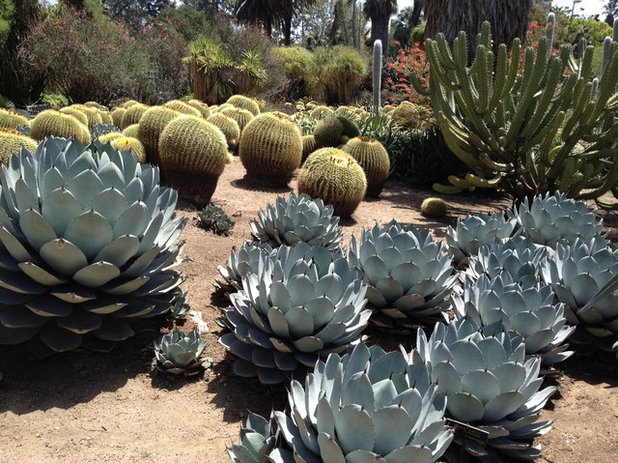 4. Succulent gardens can play, too.
4. Succulent gardens can play, too. A xeric or desert garden has a different aesthetic than a small front garden border or a larger, meadow-inspired landscape, but you can still use the principles of drifts and masses to mimic and interpret what you’d find in nature. Look at how the plants in this design at The Huntington botanical gardens are at play, with more formal golden barrel cactus (
Echinocactus grusonii, zone 8) contrasting the spiked Parry’s agave (
Agave parryi var.
truncata,
zones 4 to 11), and notice how some are evenly spaced and others more haphazardly positioned to reflect how they might appear in the wild.
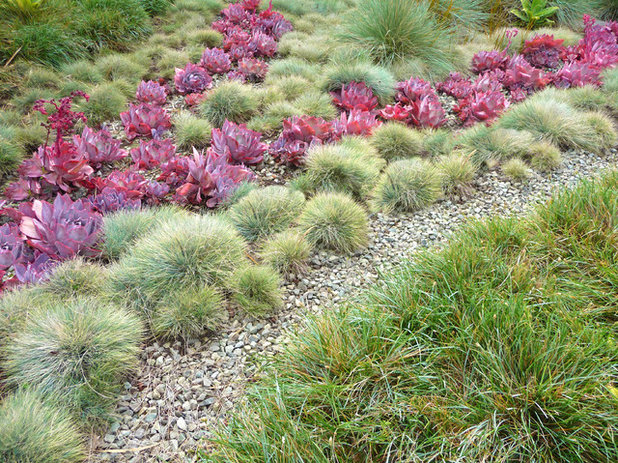
Kiesel Design - Landscape Architecture
Of course you can be more more formal with succulents too, as in this space, where purple echeveria is woven among grasses. You can clearly see the larger pattern of the drifts forming in this close-up of the garden, and how similar heights help the landscape feel cohesive and thought out.
Plants shown: Echeveria (
Echeveria ‘Afterglow’, zones 8 to 11), Elijah blue fescue (
Festuca ‘Elijah Blue’, zones 4 to 8), blue moor grass (
Sesleria caerulea,
zones 5 to 9) and blue oat grass (
Helictotrichon sempervirens,
zones 4 to 8), with a mix of blue foxtail agave (
Agave attenuata ‘Nova’, zones 10 to 11) and orange Libertia (
Libertia peregrinans,
zones 8 to 10)
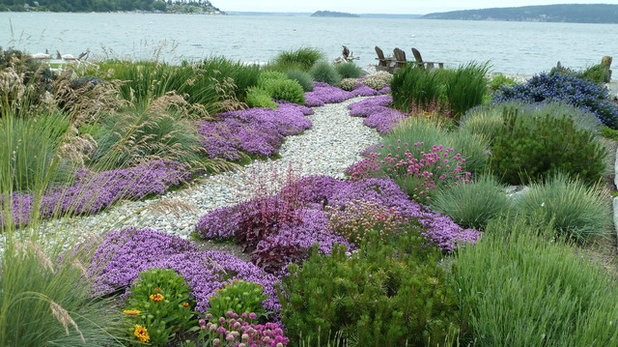
Lankford Associates Landscape Architects
5. Ground covers level and focus the visual field. Here’s a great example of how the ground plane, filled with one blooming plant, can draw the eye forward through a design. The gravel path leads us into the larger planting and out to the water, but the creeping thyme (
Thymus serpyllum, zones 4 to 8) ground cover frames and guides, too, like runway lights. If there were a variety of flowering species down low, we’d get lost in the visual chaos, and the calm and serenity the garden is evoking would be lost. Even though this is a water’s-edge scene, I can’t help but think of a woodland trail. There, you’d see the trail edge filled with a few species all adrift as they move deeper into the forest canopy.
Plants shown: Creeping thyme, blue oat grass, Siberian iris (
Iris sibirica, zones 4 to 9), Victoria California lilac (
Ceanothus ‘Victoria’, zones 8 to 10), Palace Purple coral bells (
Heuchera micrantha ‘Palace Purple’, zones 4 to 9)
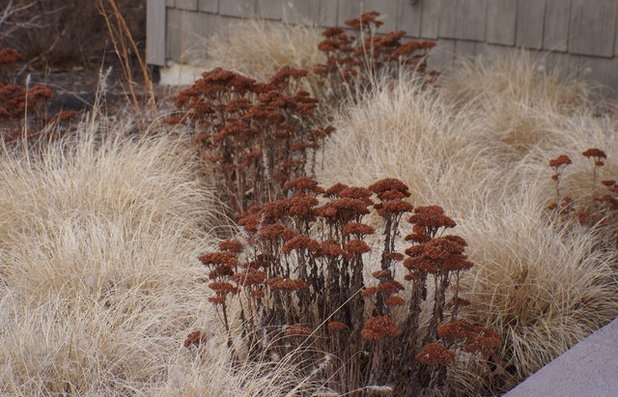
Adam Woodruff + Associates, Garden Artisans
6. Winter matters. Don’t just think about how plants look in summer while in bloom. Look ahead to the cold season when some pretty stunning displays also happen. Long after the petals have wilted, what structure will your plants carry through the winter? What subtle, earthen tones will they hold, and how can you play them off one another?
7 Reasons Not to ‘Clean Up’ Your Fall Garden
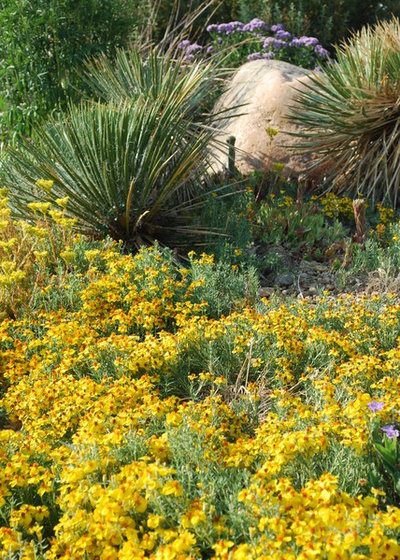
Jocelyn H. Chilvers
7. Group flowers for pollinators. You can make it easier for bees and butterflies flying overhead to spot a great pit stop. Drifts and masses of blooming plants, like this Rocky Mountain zinnia (
Zinnia grandiflora,
zones 4 to 7) provide a more powerful beacon than solitary or scattered plants. So when you mass your species — say, in groups of three, five or seven — you’re not just bringing cohesion and balance to your landscape, you’re providing a lighthouse for pollinators.
Tell us: How do you use masses and drifts in your garden? Upload photos in the Comments.





